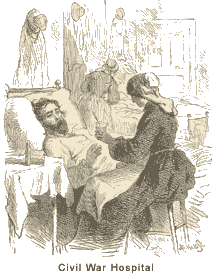Following the Confederate victory at Chancellorsville, Lee decided to invade the North. He hoped such a move would further demoralize the Peace Democrats and might also, if successful, convince the Europeans that they should extend diplomatic recognition. In the spring of 1863, the Confederate army moved northward through the Shenandoah Valley, across Maryland's panhandle and into southern Pennsylvania.
President Lincoln made another change in command, replacing Joseph Hooker with General George G. Meade. The Union army shadowed the invading force, attempting to stay between Lee and Washington, D.C.
Neither commander intended to engage the other at Gettysburg. In fact, neither Lee nor Meade was present on the first day of the battle. The initial encounter on July 1 happened by accident.
Confederate forces set out to search for shoes in a nearby factory and met with a contingent of Union cavalry. Shots were exchanged, additional forces gathered and heavy fighting ensued. The opposing armies ended the day with the Union forces occupying a defensive position on Cemetery Ridge south of Gettysburg and Confederate soldiers occupied Seminary Ridge to the west. In all, Lee’s force numbered about 75,000 and Meade’s, 90,000.
On July 2, heavy fighting persisted through most of the day. A crucial maneuver was the Confederate effort to take Cemetery Ridge. Despite withering fire, the Union line was broken by advancing Confederate soldiers, but they were unable to hold their position.
 Lee and his lieutenants heatedly debated plans for July 3. Lee favored a massive frontal assault, but was opposed by others who remembered Burnside’s costly charge. Lee prevailed, of course, and ordered General George E. Pickett's fresh forces to lead the way.
Lee and his lieutenants heatedly debated plans for July 3. Lee favored a massive frontal assault, but was opposed by others who remembered Burnside’s costly charge. Lee prevailed, of course, and ordered General George E. Pickett's fresh forces to lead the way.
A Confederate force of about 15,000 men moved across a mile of open land, receiving constant fire from the entrenched Union soldiers. Perhaps a few thousand Confederates made it to the top of the ridge where the Union line was broken — often referred to as the “high water mark of the confederacy.” Union forces rallied and the Southern hold lasted only about 20 minutes. The Confederates were forced back down the hill and they retreated in disarray.
On July 4, Lee and his dispirited soldiers awaited a massive Union attack, which never came. In the evening, during a heavy rainstorm, the Confederate forces retreated into Virginia. Lincoln was very critical of Meade for not actively pursuing the departing force.
The toll from the fighting at Gettysburg was 23,000 casualties for the Union and 20,000 for the Confederates.
Gettysburg was the turning point in the war, especially occurring in tandem with the Union victory at Vicksburg. The South would not be able to mount another major offensive for the remainder of the conflict.
Meade is generally given high marks for conducting a skilled defense of the Union position. Lee, however, did not perform as ably. His decision to strike at the Union’s center on July 3 (Pickett’s Charge) was his most ill-considered of the war; some of his advisors had suggested before the battle that it would be wiser to wait and force Meade’s soldiers to attack.